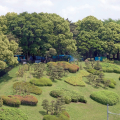MEIJI-JINGU SHRINE
A haven of calm and coolness in the middle of Harajuku, the Shinto shrine dedicated to the Meiji emperor is also the largest in Tokyo.
Comfortably set in the heart of a beautiful 72-hectare park, it is dedicated to the divine souls of Emperor Meiji, who died in 1912, and his wife Empress Shōken, who passed away in 1941. It was built between 1912 and 1920, and over 100,000 trees from all over Japan were planted there to honor their memory. Emperor Meiji (1852-1912), Japan's 122nd emperor, is famous for leading the opening up and modernization of Japan in the Meiji era of "enlightened government." During his reign, a constitutional system was established and the old social hierarchies were abolished, laying the foundation for a nation-state.
It is the largest Shinto place of worship in the country. Weddings and other ceremonies such as Shichi-go-san (children's festival of 3, 5 and 7 years old) are regularly celebrated there. Therefore, it is recommended to follow certain etiquette principles such as purifying the body with water or bowing to the torii. In the courtyard of the main building, one hangs one's wishes on the offering trees. Waka, poems composed by the emperor and his wife and of which they were particularly fond, are offered to visitors. Forms, letters to the deities (kami), and ema, wooden tablets bearing wishes, are available to all, for a fee. The priests then collect the messages and address them to the kami. All these little things are very nice souvenirs to bring back home.
The entrance to the park is through the large cypress woodtorii from Mount Alishan in Taiwan. Paths lead to the various buildings that make up the shrine. In addition to the kaguraden, a music and dance hall built in the 1990's, one can also see the main structure - the honden - built in the nagare-zukuri style, and the noritoden where the liturgy is recited. At the back of the shrine is the Treasury Building, where objects related to the emperor are displayed. In October 2019, a museum designed by Kengo Kuma dedicated to the history of the Meiji period opened in the park to mark the 100th anniversary of the inauguration of the place. Not far from the main torii, there is a nice garden (entrance fee required) where you can see a beautiful iris bed in June. During the hot summer months, this whole area forms a real oasis where the temperature is a little lower than in the city. Ideal to regain strength in the middle of the day, but beware of mosquito bites!
Members' reviews on MEIJI-JINGU SHRINE








